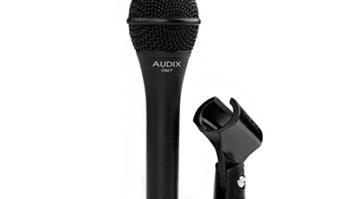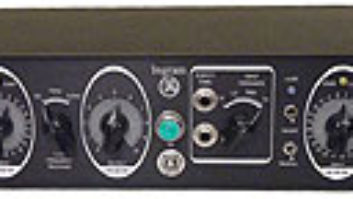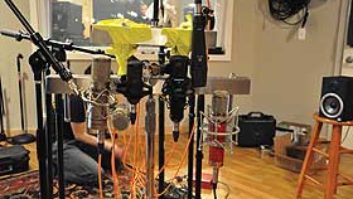I just completed seven exhausting weeks of testing mic preamps for an educational video. It started last fall when I was asked to do a preamp shootout. I’ll admit to shunning the shootout. Lynn Fuston of 3D Audio in Nashville has a well-deserved niche in that area, so there’s no reason to reinvent his wheel. I always wanted to explore the fringes of preamp performance — overload characteristics and noise floor — deviating from just about every convention in the process, starting with one mic driving six preamps.
Typically, mics have a 150-ohm to 200-ohm output impedance. Ribbon mics are typically 50 ohms, while the “load” (a preamp’s input impedance) is about 10 times higher and therefore considered a “bridging” input. With that range as reference, the six preamps represented a potential load of between 250 and 333 ohms. Two mics were tested to observe their reaction to an eight-preamp load — a Shure SM57 dropped about 10 dB as compared to a nearly 4dB level drop for an AKG C 414 EB. (See Figs. 1a and 1b.)
The goal was not to compare preamps for their sound under normal conditions as much as it was to observe their overload characteristics, each responding to the same stimuli — a snare drum from soft to loud, for example. One mic driving six preamps was not going to sound the same as it would solo. With their inputs tied together, six mics would likely cross-pollinate whatever character that part of the circuit may have contributed. That said, I investigated some of the interface alternatives.
Figures 1a/1b: two mics driving one Great River MP-2NV preamp (top, in red) and eight preamps (bottom, in green). Note pink noise was electronically injected into the Shure SM57, while the AKG C414 EB responded to an acoustic stimulus (hence, the funky curve).
Starting with a hard-wired mult box, the next step was to add a resistive network to isolate the preamps from each other. This had a dual effect as both a signal attenuator (pad) and presenting a similar load to the mic as if it were driving the preamps directly, further lowering the signal. And so the third driving option was to recover the loss by inserting a neutral preamp — a Crane Song Flamingo — between the mic and the resistive mult box. If that weren’t enough, I also dangled six Shure SM57s about two feet over a snare drum, each directly driving a preamp. Other mics included the Josephson C617SET (omni), DPA 4006 (omni), and Nady TCM-1050 and TCM-1150. (The Nadys are multipattern tube condensers.)
Level matching was confirmed by inverting the polarity of one track so that only the difference between it and the other tracks remained. This also revealed phase shift between pre’s of different topology, whether a device was terminated or not, and distortion artifacts that would have been masked by the intensity of the snare hits.
THE USUAL SUSPECTS
I evaluated several preamps before selecting the six that represented three overload categories: linear (hard clipping, typical of op amps), medium (vintage solid-state) and soft (think tubes). No topology has exclusivity on these features, but the inherent linearity of op amps and digital audio requires us to pay much more attention to headroom — perhaps most obvious with drums.
The available solid-state preamps with a known “medium” overload characteristic included the Neve 1066, 1073 and a modified 1272, along with a Great River MP-2NV and a Telefunken V672.
The first step was to determine the point at which the unit’s front end went into overload. Not only did I confirm the MP-2NV and the 1073 distorted in the same way, but with minor power supply tweaks, they were able to do so at the exact same place. See the table for the full list.
The linear preamps tested — Mackie and API — are IC- and discrete op amp — based, respectively, and were not allowed to clip. The Crane Song Flamingo plays both sides of the fence with its optional Iron (transformer) and Fat settings. An original UREI LA-3 was also used as a preamp because it has 50 dB of gain when the input attenuator is “out.” That left the rather obscure Pultec MB-1 (similar to the Altec 1566A) to represent the vacuum tube’s sonic contribution, which was modified to run with and without negative feedback to be both clean (stock) and colorful (no feedback).
HEADROOM, AND THEN SOME
The next step was to set levels so that the preamps would overload within 3 to 6 dB of the maximum allowed by the A/D converter: an Alesis AI-3 (feeding a Digi 002 into Pro Tools LE running on a Sony Vaio laptop). Most vintage gear has the ability to output signals much higher than any converter can tolerate, revealing an AI-3 design flaw that required modification to resolve. Test points were added to the AI-3 so levels could be monitored from within the converter. Preamp levels were matched by inverting polarity, then subtracting (nulling) via oscilloscope.
Figure 2: Successively louder snare hits, as captured by six preamps. Note how a purposely overloaded preamp levels the transients like a peak limiter.
I JUST WANT TO BANG ON THE DRUM ALL DAY
The early snare tests were single hits, from soft to loud. You can see the results in Fig. 2. Notice how the transients increase on all but the Great River and Crane Song (with Iron and Fat on). These two solid-state preamps allow this to happen fairly transparently.
Once the setup was optimized, I moved on to a full kit recording using an omni mic just above the beater side of the kick, pointed at the drummer’s seat. I like that a single mic can capture a remarkably balanced mix of the kit.
SO WHAT?
After all of this, you may be wondering what it all sounded like. The result of optimizing gain structure is to take advantage of the desirable overload characteristics so that the drums can be pushed louder in a mix without compromising dynamics. (Yes, peak limiting has the same effect.) The combination surprised those involved with the project, and in that sense, my goal was accomplished.
If you’re curious about whether any one preamp was better than the other or whether there was a significant difference between affordable and boutique, there are several ways to answer. I’ll let you be the judge of the sonic differences. The easy answer to the cost vs. performance question is that, at minimum, a more expensive preamp should provide more years of trouble-free service. Better preamps should have less electronic noise (hiss and hum), be less susceptible to radiated noises, have more headroom and be capable of driving any load — including massive lengths of cable — without loss of quality.
EARS WIDE OPEN
Moving from drums to vocals reinforced the importance of matching a microphone with a vocalist. The journey through two transducers — mic and loudspeaker — can be, in my opinion, the most sonically challenging obstacle course for what is the most familiar, natural sound: the human voice.
I expect to be much more critical of these issues — to the point of taking more time to audition mic and preamp combinations before simply accepting what comes down the wire. Sound and video samples will eventually make it to www.tangible-technology.com. A fully detailed DVD will hopefully be ready sometime this spring.
Eddie would like to thank Tom Tucker for the inspiration; Dan Whitney for the blood, sweat and ears; Logan Erickson for the mods; Dan Kennedy for the geek analysis; and the performers: Will Charlton and Joe Ingle (drums), Brianna Rhubee (vocals) and acoustic guitarist Eric Johnston.
COOKIN’ WITH GAS
Home on the Dynamic Range
By Eddie Ciletti
Each change in audio technology has required a user-adjustment period. The migration from tubes to transistors to opamps was nothing until digital recording challenged analog tape, making us all feel like the naked emperor. While each improvement has generally ushered in lower distortion, wider dynamic range and greater linearity, the artistic side of the sonic process often requires more than just a little color; the starkness of digital having made us realize (and appreciate) just how much.
Simple vacuum tube and transistor circuits, along with analog tape, have what I like to call “The Sonic Airbag”—the ability to transparently absorb percussive transients and ease into distortion rather than crack your sonic skull against the windshield. Those circuits that yield an extended non-linear region, between clean and clipped, often have an asymmetrical distortion that generates even-order (octave) harmonics, like a resonating piece of wood on an acoustic instrument. Driving the signal harder increases the odd harmonics.
SO, WHAT IS HEADROOM, ANYWAY?
Running out of headroom is power-supply related and this is most easily visualized with a simple opamp circuit running on a bipolar power supply—that’s ±15-or-more volts, 30 volts peak-to-peak (P-P) minimum or 10.6 volts RMS. This puts clipping at +22.7dBu, 18.7dB above a nominal +4dBu, nominal level for professional equipment.
On an analog meter, “Nominal” is a solid “0 VU,” but on a digital meter, things get a bit fuzzy depending on the type of program material. Classical and sound-for-picture call nominal around -20 dBFS to –18 dBFS, while pop ranges from –14 dBFS to (sadly) about –6 dBFS. (“FS” being 0 dB Full-Scale.) The VU meter’s 300ms response time emulates the human perception of apparent loudness, averaging the signal over time. Figure-3 correlates the relationship between three sound files that register as 0 VU on an analog meter with their actual digital level.
KNEES: HARD, MEDIUM AND SOFT
When linear preamps run out of headroom, the result is the edgy fuzz of hard clipping. Opamp-based examples include preamps in just about any console—Mackie, Trident, SSL and API. Vacuum tube circuits can be just as linear, although we associate them as being more overload-tolerant. The simplest circuits—tube and transistor—have the broadest window in which to transition from linear clean to harmonically rich before actually clipping. The window is narrowed when negative feedback is employed to minimize distortion and extend the linearity.
The M-Audio Tampa does a reasonable job of elongating the desirable non-linear region using transistors. Crane Song’s HEDD emulates Triodes, Pentodes and Tape in hardware; Phoenix is the company’s software analog tape emulator plug-in for PT TDM. Discrete Class-A transistor preamps fall in-between the hard- and soft-knee overload characteristics. The Neve 1066/1073 circuit in particular has a response time not unlike a peak limiter, in that smacking it with level changes the bias, which in turn alters the symmetry of the overloaded waveform.







